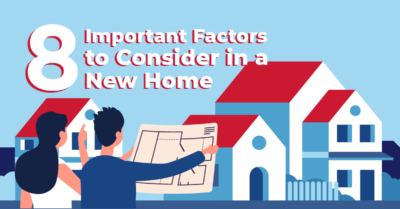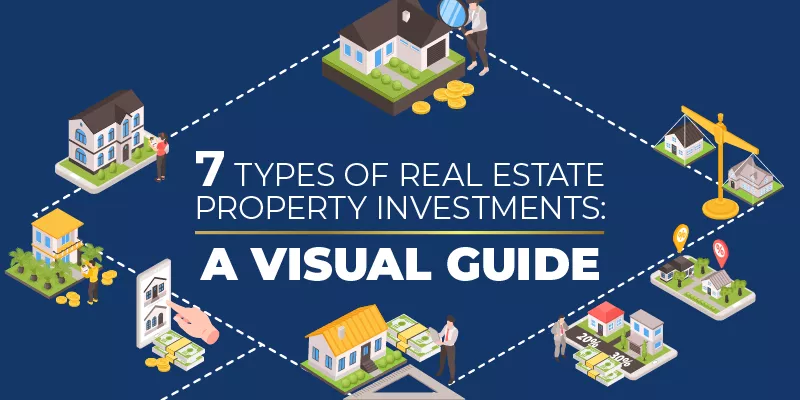Homes have always been an essential part of daily living. While this need has remained unchanged throughout the decades, there have been advances in the technology, techniques, and features used for houses in the current market. As a result, potential homeowners need to further narrow down their must-haves for their dream homes.
Each person may have different wants, needs, and priorities when it comes to finding a new home. However, some factors are essential to have on your list. This infographic will give you an overview of a few essential home factors that you need to consider in a new home.

8 Important Factors to Consider in a New Home
1. Location
While a home can be renovated or modified to suit your needs, a home’s location is pretty much set from the get-go. You can compromise on certain home features if its location is convenient, but no dream home is worth being in an area that greatly inconveniences your daily routine.
Your new home should allow you to travel to your most-frequented places—such as work, school, recreation centers, loved ones, places of worship, and so on—with ease. It should also be within reach of essential places like hospitals, groceries, banks, and the like.
If you own a car, you should check its proximity and access to main roads and throughways. For commuters, being closer to public transportation hubs is more convenient. Other points to consider for your location will depend on your needs, such as playgrounds and parks for families with children or walkable areas for pets.
2. Accessibility
Another important factor is the home’s accessibility—both inside and out. This factor is crucial for those shopping for a retirement home or families with differently-abled members.
When inspecting a home, pay attention to features like doorways, paths, and stairs. How wide are they? Are the doorways raised from the ground? Are there too many stairs to climb? How steep are the steps? Depending on your needs, these features can make all the difference when selecting a home.
For the outside, try to observe features that enable access to the house from the entrance. How far away is it from the street? Is the house raised from the ground or located in an elevated area? If there are stairs to the front door or a driveway, were these features constructed with the right safety measures?
When in doubt, do your due diligence and research these features before committing to a sale.
3. Community/Neighborhood
Living in a new home means immersing yourself in a new neighborhood and community. A good neighborhood can be beneficial in several ways. Aside from living in a place with people you can be civil and courteous with, the right neighborhood is safe, secure, and can make all the difference in the mood of your home.
If your prospective property has neighbors, consider asking them about their impressions of the community. You may get more insights into what kind of community lives in the area, how safe it is, and if there are organizations that address any homeowner concerns.
4. Home Layout/Blueprint
Some home layouts can sound amazing on paper, but they can be more than you bargained for in actuality. For example, you may be getting a good deal on a four-bedroom, two-bathroom, two-story home, but this is impractical if you’ll be living alone. Aim to find a home with a layout that best suits your needs.
For example, having extra space for a home office or crafting workshop can be exciting, but customizing these spaces to match their function can incur additional costs. A family with children may want to invest in multiple bedrooms, as they need more personal space when they get older.
A good thing to keep in mind is that the larger the home and the more features there are, the more you may need to spend on utilities and real estate taxes. The key is to consider which features are important to your current and future needs and if you can afford to sustain this lifestyle.
5. Bedrooms
Bedrooms are spaces to relax at the end of the day and get much-needed rest. Depending on your family size and lifestyle, some family members may be comfortable sharing bedrooms, but some prefer to be separate to accommodate different bedtimes or daily habits. If you often have visitors stay over, having a designated bedroom for guests may be more convenient.
Whenever possible, take note of the size of each bedroom available. Those that are too small for their occupants may be more uncomfortable to stay in for the long term. Other notable features are windows and other sources of ventilation, location of the doorway, and possible connections to other locations in the house (bathroom, hallway, or other bedrooms).
6. Bathrooms
Bathrooms are another essential feature of every home. Deciding on the number of bathrooms will still depend on your specific needs, such as the number of people and other living arrangements that might make the bathroom inaccessible for others at certain times, such as preparations for work or school.
Take note of the placement and location of the bathrooms within your prospective home. How convenient are they for people to use? If you live in a multi-story home, are there enough bathrooms to accommodate people on different floors?
Are the placements just right or too cramped? Does the bathing area have a bathtub, a shower, or both? Do they have railings and other installations to help those with special needs? Knowing who will be using the bathrooms can help answer these questions. Consulting with a professional plumber can also help certify that the layout and features won’t cause issues later on.
7. Kitchen
For those who love to cook and cater to larger groups of people, a large kitchen with lots of counter space, cooking area, and storage solutions may be better. On the flip side, smaller or single households that make simple meals or tend to order out more often may be better off with a small, more modest kitchen with few features.
You may also want to consider the kitchen’s layout in relation to the house’s dining area and other spaces. Kitchens with stoves and ovens should be equipped with the proper ventilation to prevent heat and smoke from being trapped inside.
Storage
One of the more overlooked home features is storage spaces. When looking at a home’s storage spaces, it pays to think both big and small. Individual rooms may need cabinets and drawers or an area for them if they’re not already included.
On a larger scale, you may need general storage space for items like seasonal decorations, sports equipment, and so on. Collectors or hobbyists may also want to look for shelves and cabinets that suit their specific needs.
It’s important to find storage spaces that can accommodate the number of things you plan to keep within them. Take note of how these spaces can be secured and kept safe from the elements if needed.
Perfect Home Down to the Details
Making your dream home a reality can seem simple on the surface, but it requires much planning and attention to the right details. Knowing which features are essential can help you focus on how your new home can best suit your way of living.
Looking for professionals to help with property investment? Contact the experts at RE/MAX Gold today for a free consultation.



